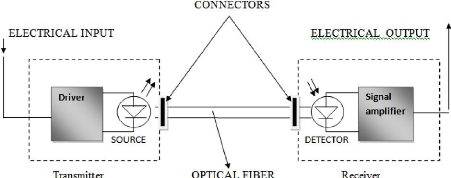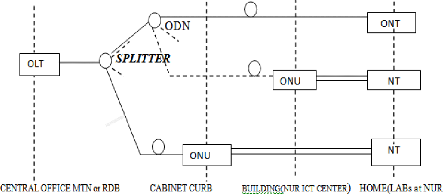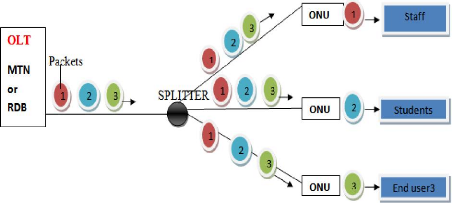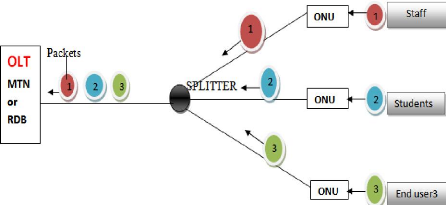CHAPTER THREE: THE ANALYSIS OF FIBER OPTIC NETWORK IN
NUR
3.1 INTRODUCTION
Fiber optics uses light signals to transmit data as this data
moves across fiber there needs to be a way to separate it so that it gets to
the proper destination, There are two important types of systems that make
fiber to the home broadband connections possible, these are active optical
networks and passive optical networks each offers ways to separate data and
route it to the proper place
3.2 THE FIBER OPTIC LINK
A fiber optic link is a transmission media which connect two
points, at NUR the fiber optic comes from Kigali where the is a backbone office
to our campus at the NUR ICT CENTER, when we send signal from one customer to
the other we use that interconnection which consists of the sending station
that converts electrical signals into light signals and the receiving station
that convert the light signals back into electrical signals those signals
contains the information or data. [11]
In addition links are also described in terms of their ability
to send and receive signals they are divided into simplex and duplex system.
Simplex means that the link can only send at one end and
receive at the other end, the signals travels in one way and example can be the
signals from the Radio station.
Duplex stand for a link which can allow signals to be
transmitted and received at each terminates. It can be broken down into
half-duplex and full-duplex: half-duplex allows the signals to go only one way
at a time where full-duplex allows users to send and receive signals at the
same time for example a telephone communication.[11]
A fiber optic link consists of three basic components:
This following figure 13 shows the parts of an optical link and
the function of each components are illustrated below:

Figure 13 : Basic Optical System
Transmitter that convert the electrical signal input which can
be data pulse or analogue signals into variations of optical power at the
desired wavelength and send the light into the fiber ,the device to perform the
task is the light emitting diode LED or LASER diode .
The optical fiber that carries the light which provides the
communication medium. it can be single mode or multi-mode at our campus we use
single mode because it transmit data at long distance without attenuation .
Receiver which converts the received optical power from the
optical fiber back to the electrical signal and the device which performs the
tasks is the optical detector. and the signal is amplified to increase its
amplitude
Furthermore we have also what we call The connectors that
couple the optical fiber to the transmitter and receiver an example can be
pig-tails a short length of optical fiber with a connector fitted at one end
and the other end in intimate optical contact with the source.[11]
3.3 PASSIVE OPTICAL NETWORK.
A passive optical network (PON) is defined as optical access
networks that starts from an operator central office in my case study are MTN
fiber optic and RDB fiber to the individual homes here it is our campus NUR ICT
CENTER .
PONs are characterized by the absence of on any active
components it uses optical splitters to separate and collect optical signals
when they move through the network.
Furthermore PONs are also systems that brings all signals to the
customers according on where the PONs terminates.

Figure 14. General structure of a PON
The figure 14 above explains how fiber optic arrives to the end
users whom can be The students
in the computer labs or on their laptops or
staff in their offices named home in the structure from
the central office called OLT ( Optical line termination) MTN
or RDB Central operators offices to the ONUs optical network unit According
where the fiber goes here it may be a cabinet distribution located at NYANZA or
same where else along the way from central offices all users have access to the
services offered by the network through the network terminal NT and to the
optical network through ONU or ONT. This OLT is the interface between all users
connected to the given PON.
Hence we have also ODN Optical distribution network which
works as the PON splitters they are used to share resources to the other users
in the same network by creating the link to the other customers they can be
arranged in star, ring or tree configurations to increase reliability.[12]
In addition according to the general structure of PON shown above
,PONs can be deployed in a FTTH fiber to home where an ONU is provided at the
subscriber?s premises or FTTB fiber to the building where the optical fiber
terminates before actually reaching the subscriber?s living or working space
itself , FTTC Fiber to the curb or cabinet this is installed in a street along
way side cabinet and is used as the connection between the OLT the central
office and the ONU which is the cabinet the local access network of the fiber
.[13]
3.3.1 ETHERNET PASSSIVE OPTIC NETWORK
Ethernet passive optical network EPON consists of an Optical
Line Termination (OLT) at the communication company's office and a number of
Optical Network Units (ONUs) near end users which are the cabinet distribution
centers and up to 32 ONUs can be connected to an OLT.

Figure 15 . Downstream Traffic Flow in an Ethernet PON
This figure 15 the data from the OLT to be sent to the
different ONUs must queue with no time delay between them in the EPON where
this serves as a trunk ,fiber optic link between a larger system and the home
Ethernet user hence splitter is used to separate packets according to theirs
respective destination .[14]
Downstream signals coming from the central office is broadcast
to each customer premises sharing a fiber and data Encryption is used to
prevent eavesdropping to keep the information out of the hands of unauthorized
people.
We have also the following figure for upstream data flow in the
EPON which shows as how packets are putted or uploaded on the network.

Figure 16. Upstream Traffic Flow in an Ethernet PON
The customer which is represented by an ONUs may need to
upload or sent packets to the other user in same or different network, Upstream
signals are combined using a multiple access protocol usually time division
multiple access (TDMA) then the OLTs range the ONUs packets in order to provide
time slot assignments for upstream communication without collisions and packets
fragmentation .[14]
| 


